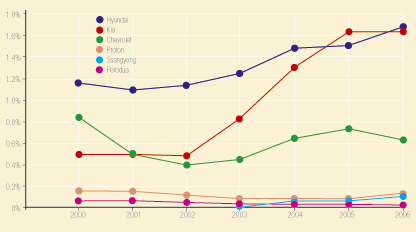Review
The Naza Sutera (silk in Malay) is a perfect example of the globalized motor industry: the basic design comes from a Chinese model, the engine is from Daihatsu, the styling has been refined by Pininfarina and assembly will be in Malaysia.
The problem is that the UK has taken a good look at Malaysian cars in the past and decided that it does not like them – at least not at the prices offered. Proton’s value prices took it to 1% of the market, but lost share as prices increased. It is now trumpeting success because it has grown from 0.07% in 2005 to 0.12% in 2006.
However, the fact that it was overtaken by new boy SsangYong in April puts it into perspective. With the backing of China’s ultra-ambitious and cash-rich SAIC, SsangYong could be a brand to watch.
Meanwhile, Perodua exists in a kind of half-life, taking 0.02%. For both Proton and Perodua, the problem is basically the same: an abundance of offers on mainstream models from the likes of Ford and Citroen. If a new C1 can be had for less than £6,000, a list price of £4,792 for the cheapest Perodua is too high.
Moving to Korea, GM-owned Chevrolet has got a lot of ground to make up after Daewoo’s suicidal dash for growth. The company must have high hopes for the forthcoming Antara off-roader: it could really stand out as a cut-price RAV4 alternative.
The big growth story of the last few years, Kia, is now focusing on its dealer network and customer satisfaction. The danger in this market is that sudden growth spurts can rapidly be reversed if a solid infrastructure is not in place.
The most senior Korean, Hyundai, is taking a more measured approach. It is optimistic that the new Santa Fe can finally move it out of the bargain-basement. In a way, it is surprising Hyundai has made such good progress with nothing in the centre of the market. It will not be until around 2008 that a competitive European-made lower medium model appears.
So, going back to Naza, the prospects don’t look bright. Hyundai and Kia are doing better mainly because their cars have got better: a Picanto, Getz or Santa Fe can compete on merit and then throw in a good price as a bonus. An unknown city car is not going to make it by being a little cheaper than, say, a new Fiat – it will have to be cheaper than a nearly-new Fiat.
Value brands market share

While Hyundai has been making steady progress, it has been a roller-coaster for Chevrolet as it tries to establish a firm footing in the UK. Kia has a profile best described as “unusual”.
Proton has made some progress with the new Savvy, but it is hard to see how such a tiny company can continue as an independent. SsangYong, backed by the Chinese, seems a better long-term growth bet.

Hyundai Santa Fe competes on merit and with a good price as a bonus
Factsheet
No information available.













Login to comment
Comments
No comments have been made yet.